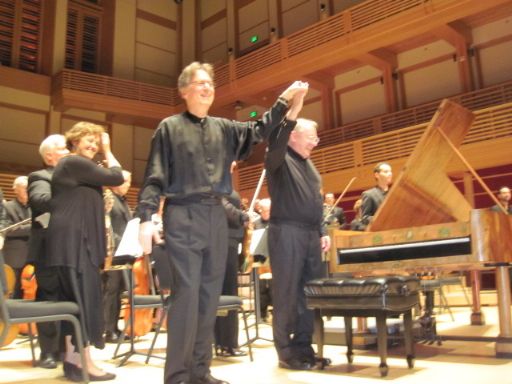|
Symphony
MONUMENTAL MAHLER 5TH IN SO CO PHIL'S SEASON ENDING CONCERT
by Terry McNeill
Sunday, April 14, 2024
Symphony
YOUTH ORCHESTRA CHARMS BIG SPRING LAKE AUDIENCE
by Terry McNeill
Wednesday, February 28, 2024
Symphony
SOLO BRILLIANCE IN SANTA ROSA SYMPHONY CONCERT
by Terry McNeill
Saturday, February 17, 2024
Symphony
HAYDEN'S SAXOPHONE CONCERTO AT SO CO PHIL CONCERT
by Ron Teplitz
Sunday, January 28, 2024
Symphony
SCHUBERT AND MENDELSSOHN BOUQUETS AT COLLEGE OF MARIN CONCERT
by Abby Wasserman
Saturday, December 9, 2023
Symphony
SYMPHONY'S MESSIAH ORATORIO A STUNNING HOLIDAY SUCCESS
by Pamela Hicks Gailey
Sunday, December 3, 2023
Symphony
TWO ORCHESTRAS AND FIVE DISPARATE WORKS IN WEILL HALL
by Ron Teplitz
Sunday, November 19, 2023
Symphony
MARIN SYMPHONY'S CHAMBER ENSEMBLE DAZZLES IN NEW SEASON CONCERT
by Abby Wasserman
Saturday, November 11, 2023
Symphony
TITANIC SRS MAHLER SYMPHONY IN WEILL NOV. 5
by Terry McNeill
Sunday, November 5, 2023
Symphony
PROFOUND SCHUMANN CONCERTO PERFORMANCE BY BRESHEARS AT THE JACKSON
by Terry McNeill
Sunday, October 29, 2023
|
 |
 Robert Levin (left) and Nicholas McGegan in Weill Hall Oct. 15 |
BAROQUE NO MORE IN STIRRING BEETOVEN CONCERT IN WEILL
by Terry McNeill
Saturday, October 15, 2016
Seasoned listeners for Beethoven’s symphonies and concertos know that interpretations can follow contemporary fashion, from the heroic and sonorous grand manner readings of the late 19th and early 20th centuries to the architectural approach after WW II, and even conductor Roger Norrington’s recent sleek and fast renderings.
In Weill Hall on Oct. 15, conductor Nicholas McGegan fashioned persuasive readings of Beethoven's Sixth Symphony and third Piano Concerto with his Philharmonia Baroque Orchestra, an ensemble sharply reduced in size (30 musicians) from convention, and with soloist Robert Levin using an 1820-era fortepiano rather than the hall’s usual concert grand.
The Op. 37 C Minor Concerto occupied the entire first half and Mr. Levin’s performance captured the energy inherent in the composition that, unlike the composer’s later two piano concertos, never quite breaks out. Following the long orchestral introduction with fine clarinet (Bryan Conger) and flute (Janet See) playing, the piano’s reduced sound sparkled in fast runs but sporadically was lost in the sonic fabric. In comments to the audience Mr. Levin said he would discard Beethoven’s much-loved first-movement cadenza and would improvise one, as well as similar but shorter cadenzas in the second and third movements.
This he did artistically and as well he played through tuttis, something never seen (or heard, as the piano’s sound here was almost mute) in Weill. A soloist playing inside the orchestra fabric (Golden Age pianists like Hofmann and Busoni did this in movement-ending tuttis) is simply not done now, but with the fortepiano’s reduced resonance it made little difference. Mr. Levin played without pedal in the exposition and used little thereafter, highlighting left-hand sforzandos and arpeggiating chords that were not so indicated in the score but were deliciously effective. Mr. McGegan set a judicious tempo throughout.
Unexpected pianistic improvisations with lots of pedal continued in the entrancing Largo, only to be interrupted by a stuck key in the piano action, and while Mr. Levin provided witty remarks the Orchestra’s on-site technician fixed the mechanism and the movement started over. Featured here were snazzy rhythms and fast descending runs on top of the keys where the composer indicates an entire theme while depressing the pedal, and a distantly related key of E Major. Exquisite.
In the concluding Rondo there were more savory surprises with sharply etched dissonant seconds and new turns and agogics. Often the conductor looked at length over his shoulder at Mr. Levin, waiting for the extemporizing to end and to cue the orchestra to enter. It was a visual and sonic treat, and playing loyal in every way to Beethoven’s intentions. The last cadenza was gay and even coquettish, and again Mr. Conger’s clarinet solos were superb.
Following intermission the F Major “Pastoral” Symphony was played, Beethoven’s only symphony with a set literary program. However bucolic, Mr. McGegan’s tempos were hardly pastoral and he charged quickly ahead with little attention to ritards or spaces between long phrases. But make no mistake, the conductor was a master of small details in this extraordinary music and drew from the Orchestra playing of distinct articulation and luminous sound. The winds were captivating, especially oboist Marc Schachman and bassoonist Andrew Schwartz. Less impressive were wrong notes from the valveless horns, and often in runs they were unable to match tempo.
In the Andante, Mr. McGegan adroitly brought out the bird call flourishes that for me were mixtures of mockingbirds and thrushes, and the trading of wind phrases (Lars Johannesson’s piccolo, Mindy Rosenfeld’s flute, Mr. Conger’s clarinet) were always exemplary. In the Allegro third and fourth movements Mr. McGegan summoned dramatic contrasts and moved convincingly between agitated and slightly raw dances (“Merry Gathering”) to a musical thunderstorm of palpable ferocity. Weill’s orchestra clarity was in evidence, as was Kent Reed's timpani playing.
The final Allegretto was transitional and transparent with the dignified main theme played resplendently by the violins over a pizzicato line in bass and cello. It sounded strangely “modern,” certainly a tribute to the composer’s amazing skill at variation and creativity, and Mr. McGegan’s strict tempos and deft control.
It was a performance of clarity and vigor, and for the audience of 500 seated solely in the Hall’s orchestra section there was no reason to regret the absence of a numerically larger ensemble.
To the standing ovation no encore was offered.
|

